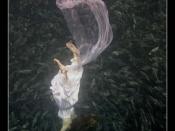Often times at the ocean, a pole can be seen protruding from the beneath the water. As the tide rises, less of the pole is visible. As it falls, more of it is visible. The pole stands as a stationary entity whose purpose is merely to measure the tide, the dynamic entity. In Kate Chopin's The Awakening, Mme. Ratignolle stands as the static character by which the dynamic character, Edna, may be contrasted.
The tide rises while Edna vacations at the Grand Isle. It is here that Edna begins "to realize her position in the universe as a human being," recognizing her interpersonal relations with others and intrapersonal relations with herself (15). Here, Chopin introduces Adèle as a character that provokes Edna's unorthodox views on matrimony and maternity, indicating that, "the two women did not appear to understand each other or to be talking the same language" (51). At this point in the novella, Edna has reached the apex of a wave in her metamorphosis.
Henceforth, as Edna returns to the city, she falls hopelessly out of control in her own metaphysical dilemma, passing from a tender mother to a distant wretch. She takes up painting in order to further immerse herself in herself. She becomes divorced from her children and M. Pontellier, becoming less a mother, less a wife or parent, until eventually scarcely a guardian or companion. She discards the interpersonal connections that she had explored while on vacation, especially disregarding contact with her family. Whereas, Adèle "worshiped" her husband and "idolized" her children , Edna would not stand for this subservience (8). By striving against her husband and children and falling into dark delusions of their "drive" to "possess her, body and soul," Edna finds herself drowning in a sea of defiance against only herself (124).



Just a thought
Try to extend the end. I think you can make it better.
0 out of 0 people found this comment useful.